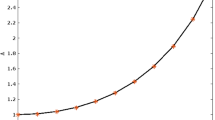Abstract
In this paper, an oversampling collocation method based on shifted generalized Jacobi functions as a set of basis is proposed to find the numerical solutions of Volterra integral equations with contaminated data. We proved that the oversampling collocation method decreases the covariance matrix of the coefficients vector of the approximated solution in the sense of 2-norm, which indicates the oversampling collocation method is more robust(which means anti-jamming of white noise) than the standard collocation method when the right side of the Volterra equation has contaminated data. Numerical experiments demonstrate the effectiveness of this method and its consistency with the theoretical analysis.









Similar content being viewed by others
References
Levinson, N.: A nonlinear Volterra equation arising in the theory of superfluidity. J. Math. Anal. Appl. 1(1), 1–11 (1960)
Wang, F.J.: Asymptotic behavior of some deterministic epidemic models. SIAM J. Math. Anal. 9(3), 529–534 (1978)
Shaw, S., Warby, M.K., Whiteman, J.R.: Error estimates with sharp constants for a fading memory Volterra problem in linear solid viscoelasticity. SIAM J. Numer. Anal. 34(3), 1237–1254 (1997)
Volterra, V.: Theory of Functionals and of Integral and Integro-differential Equations. Blackie and Son Ltd., London and Glasgow (1930)
Zhao, D., Luo, M.: Representations of acting processes and memory effects: general fractional derivative and its application to theory of heat conduction with finite wave speeds. Appl. Math. Comput. 346, 531–544 (2019)
Zhao, D., Sun, H.G.: Anomalous relaxation model based on the fractional derivative with a Prabhakar-like kernel. Z. Angew. Math. Phys. 70(2), 42 (2019)
Atkinson, K.E.: The Numerical Solution of Integral Equations of the Second Kind. Cambridge University Press, New York (1997)
Diethelm, K., Ford, N.J.: Analysis of fractional differential equations. J. Math. Anal. Appl. 265(2), 229–248 (2002)
Brunner, H.: On the history of numerical methods for Volterra integral equations. CWI Newslett. 11, 3–20 (1986)
Mirzaee, F., Hadadiyan, E.: A collocation technique for solving nonlinear stochastic Ito-Volterra integral equations. Appl. Math. Comput. 247, 1011–1020 (2014)
Mohammadi, F.: A wavelet-based computational method for solving stochastic Ito-Volterra integral equations. J. Comput. Phys. 298, 254–265 (2015)
Mirzaee, F., Samadyar, N.: Application of operational matrices for solving system of linear Stratonovich Volterra integral equation. J. Comput. Appl. Math. 320, 164–175 (2017)
Khodabin, M., Maleknejad, K., Damercheli, T.: Approximate solution of the stochastic Volterra integral equations via expansion method. Int. J. Ind. Math. 6(1), 41–48 (2014)
Shen, J., Sheng, C., Wang, Z.: Generalized jacobi spectral-Galerkin method for nonlinear volterra integral equations with weakly singular kernels. J. Math. Study 48(4), 315–329 (2015)
Gibbs, A., Hewett, D.P., Huybrechs, D., Parolin, E.: Fast hybrid numerical-asymptotic boundary element methods for high frequency screen and aperture problems based on least-squares collocation. SN Partial Differ. Equ. Appl. 1, 21 (2020)
Stewart, G.W.: On the perturbation of pseudo-inverses, projections and linear least squares problems. SIAM Rev. 19(4), 634–662 (1977)
Linz, P.: Analytical and Numerical Methods for Volterra Equations. Society for Industrial and Applied Mathematics, Philadelphia (1985)
Brunner, H.: Collocation Methods for Volterra Integral and Related Functional Differential Equations. Cambridge University Press, New York (2004)
Szego, G.: Orthogonal Polynomials. American Mathematical Society, Providence (1975)
Beals, R., Wong, R.: Special Functions and Orthogonal Polynomials. Cambridge University Press, Cambridge (2016)
Chen, S., Shen, J., Wang, L.L.: Generalized Jacobi functions and their applications to fractional differential equations. Math. Comput. 85(300), 1603–1638 (2016)
Zayernouri, M., Karniadakis, G.E.: Fractional Sturm-Liouville eigen-problems: theory and numerical approximation. J. Comput. Phys. 252, 495–517 (2013)
Uchaikin, V.V.: Fractional Derivatives for Physicists and Engineers. Springer, Berlin (2013)
Samko, S.G., Kilbas, A.A., Marichev, O.I.: Fractional Integrals and Derivatives, Theory and Applications. Gordon and Breach, Singapore (1993)
Tang, T., Xu, X., Cheng, J.: On spectral methods for Volterra integral equations and the convergence analysis. J. Comput. Math. 26(6), 825–837 (2008)
Gander, W., Gautschi, W.: Adaptive quadrature revisited. BIT Numer. Math. 40(1), 84–101 (2000)
Zhao, Y.: Collocation methods for second kind of fractional Fredholm integral equations. Master’s thesis, Harbin Institute of Technology, 2017 (in Chinese)
Xiu, D.: Numerical Methods for Stochastic Computations: A Spectral Method Approach. Princeton University Press, Princeton and Oxford (2010)
Zhang, Z., Karniadakis, G.: Numerical Methods for Stochastic Partial Differential Equations with White Noise. Springer, Berlin (2017)
LeCun, Y., Bengio, Y., Hinton, G.: Deep learning. Nature 521(7553), 436–444 (2015)
Zhao, D., Yu, G., Li, W.: Diffusion on fractal objects modeling and its physics-informed neural network solution. Fract. Complex Geom. Patterns Scal. Nat. Soc. 29(3), 2150071 (2021)
Acknowledgements
The authors are very grateful to the reviewers for their comments and suggestions which have improved the paper. This work was supported partially by the Open Fund for the Sichuan National Applied Mathematics Center (no. 2022-KFJJ-01-002).
Author information
Authors and Affiliations
Corresponding author
Additional information
Publisher's Note
Springer Nature remains neutral with regard to jurisdictional claims in published maps and institutional affiliations.
Rights and permissions
About this article
Cite this article
Zhao, D., Pu, L. & Yu, Y. Oversampling collocation method for the Volterra integral equation with contaminated data. Calcolo 59, 29 (2022). https://doi.org/10.1007/s10092-022-00473-6
Received:
Revised:
Accepted:
Published:
DOI: https://doi.org/10.1007/s10092-022-00473-6
Keywords
- Volterra integral equation
- Contaminated data
- Oversampling
- Collocation method
- Shifted generalized Jacobi function
- White noise




